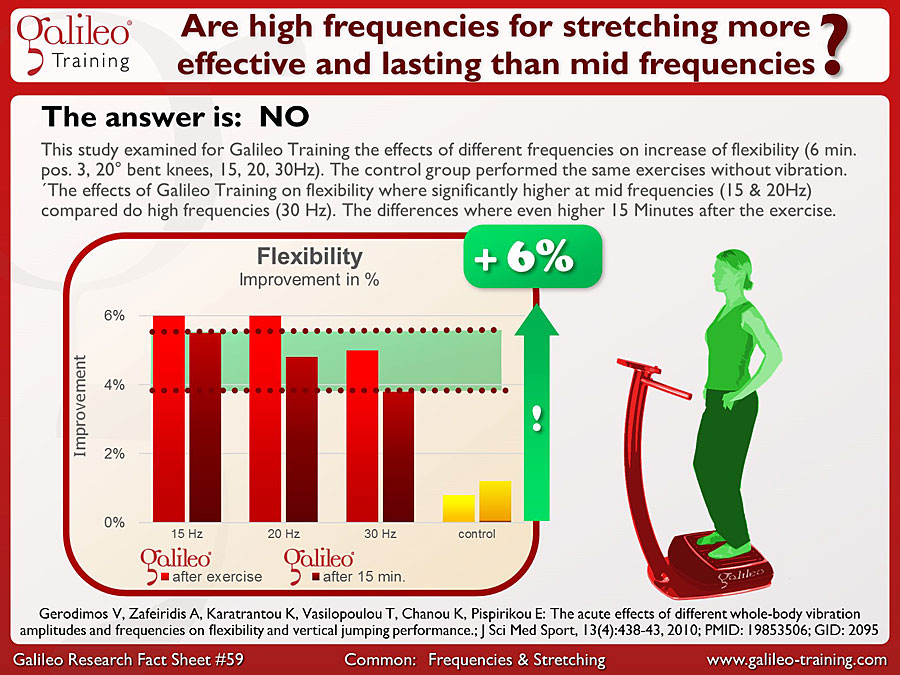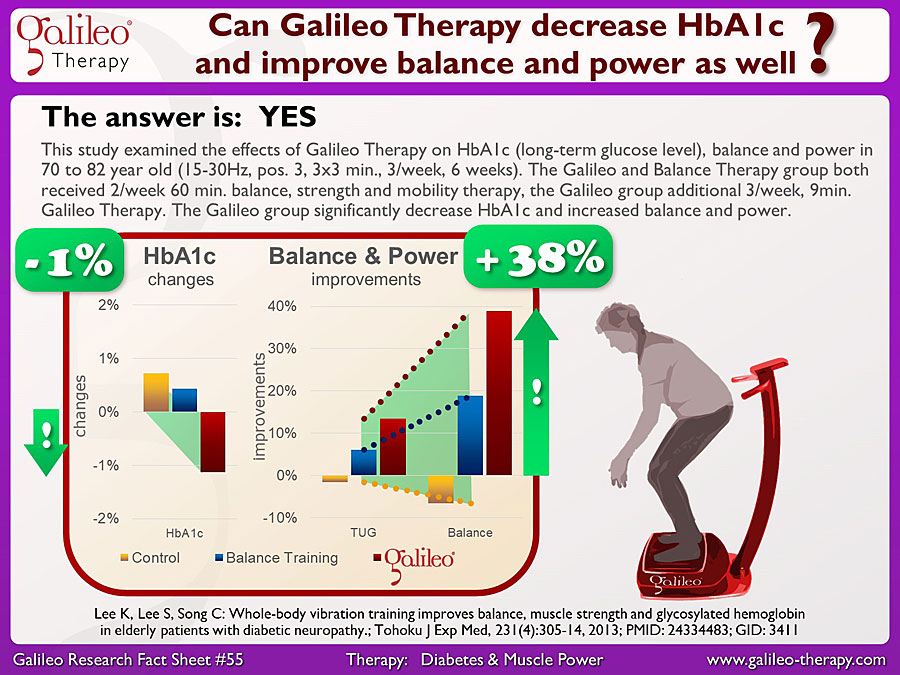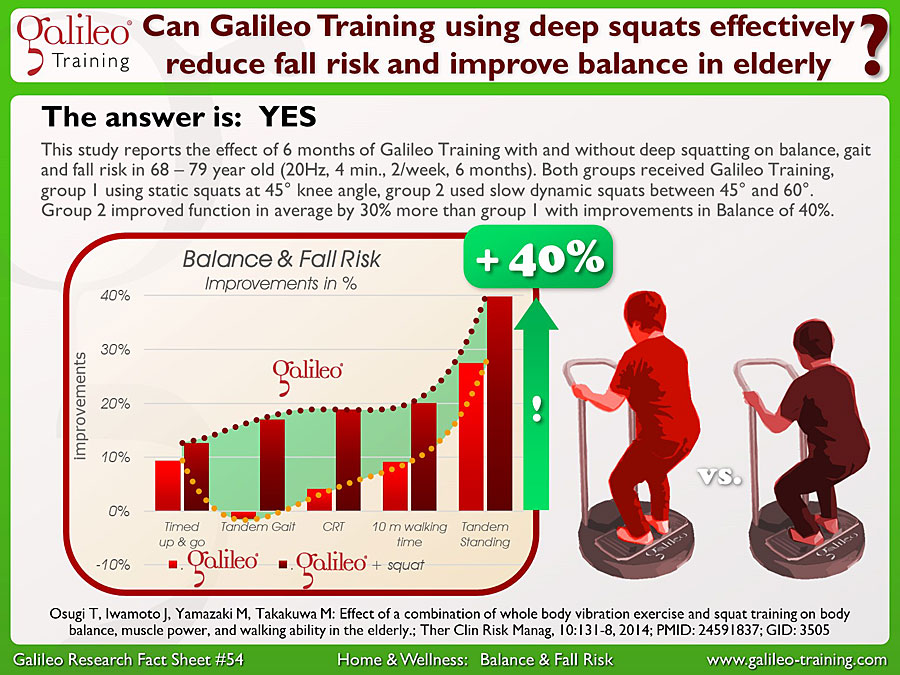Tag Archives: MechanoStimulation
This study examined the immediate effect of 20 minutes Galileo Therapy (20Hz, pos. 2, 10 minutes, 30° squat) on ankle flexor spasticity in kids with Cerebral Palsy (CP, GMFCS level 1-4, age 3-14). Participants were separated into a knee flexion and a knee extension spasticity group. In average spasticity at the ankle joint was decreased by 55% and this effect lasted up to 3 hours after the end of the 20 minutes Galileo Therapy...
Galileo Research Fact Sheet No. 63: Can Galileo Therapy increase blood-flow in the legs of Spinal Cord Injury (SCI) patients?
This study reports increases in blood-flow during Galileo Therapy, electro-stimulation (ES) and Galileo Therapy + electro-stimulation (Galileo + ES) for spinal cord injury (SCI) patients (sitting in front of Galileo, 10Hz, pos. 2.5). As a result Galileo Therapy showed the largest effect (130% increase of blood-flow) which can be improved further in combination with ES to up to 250%...
Galileo Research Facts No. 62: Can Galileo Therapy reduce pain in Chronic Fatigue Syndrome patients?
This study reported the effects of pain reduction in patients with Chronic Fatigue Syndrome (CFS) after 6 months of Galileo Therapy. The patients previously received at least 6 months of standard therapy without and improvements (18/22 Hz, pos. 4, 4x2 min., 3/week, 6 months, 4 different positions). The Galileo Therapy significantly reduced pressure pain at different muscle groups (upper back, neck, upper leg) by up to 40%...
Galileo Research Facts No. 61: Are 5 minutes Galileo Mano Training (dumbbell) an effective warm up Training?
This study reported the warming up effects of 5 minutes Galileo Mano Training (Galileo vibrating dumbbell) compared to static exercises and arm ergometer training (5*1 min, 26Hz, 5 Exercises). The control groups performed the exercises without vibration or used an arm ergometer (5 Min., 25 W, 25 rpm). Only the Galileo group showed significant improvements in EMG intensity and peak power output of up to 6%...
Galileo Research Facts No. 60: Can Galileo Training be more effective than traditional warm up exercises?
This study examined the warm up effects of Galileo Training in comparison to traditional warm up (cycling ergometer) and static exercises (5 min., 26Hz, pos. 3, 5 exercises). The control groups used identical exercises without vibration and traditional cycling ergometer (5 min. 50 W, 50 rpm). Only the Galileo Groups showed significant improvements for jumping height and flexibility (sit & reach) of more than 8%...
Galileo Research Facts No. 59: Are high frequencies for stretching more effective and lasting than mid frequencies?
This study examined for Galileo Training the effects of different frequencies on increase of flexibility (6 min. pos. 3, 20° bent knees, 15, 20, 30Hz). The control group performed the same exercises without vibration. ´The effects of Galileo Training on flexibility where significantly higher at mid frequencies (15 & 20Hz) compared do high frequencies (30 Hz). The differences where even higher 15 Minutes after the exercise...
Galileo Research Facts No. 58: Can Galileo Therapy increase muscle power and flexibility in spinal muscle atrophy (SMA)?
This study explored the effects of Galileo Therapy on muscle power and flexibility in kids with spinal muscle atrophy (SMA) (3x3min., 10/week, 18-24Hz, pos. 2., knees bent slightly, Stretching, 8 weeks, 4 weeks follow-up). Even though this study was designed as a safety study only (low intensity Galileo Therapy) it showed significant increases in muscle power and flexibility of up to 36% during just 8 weeks of Galileo Therapy...
Galileo Research Facts No. 56: Can Galileo Therapy in CP patients be more effective than standard physiotherapy?
This study examined the effects of Galileo Therapy on balance and quadriceps torque in children with CP (Cerebral Palsy) (3x3min., 12-18Hz, pos. 1-3, 5/week, 10-45° bent knees). Both groups received standard physiotherapy (5x60min. /week) the Galileo group additional 5x9 min. Galileo Therapy. The Galileo group showed more than double the improvements in balance and almost 60% increase in quadriceps peak torque...
Galileo Research Facts No. 55: Can Galileo Therapy decrease HbA1c (long-term blood sugar level) and improve balance and power as well?
This study examined the effects of Galileo Therapy on HbA1c (long-term glucose level), balance and power in 70 to 82 year old (15-30Hz, pos. 3, 3x3 min., 3/week, 6 weeks). The Galileo and Balance Therapy group both received 2/week 60 min. balance, strength and mobility therapy, the Galileo group additional 3/week, 9min. Galileo Therapy. The Galileo group significantly decrease HbA1c and increased balance and power...
Galileo Research Facts No. 54: Can Galileo Training using deep squats effectively reduce fall risk and improve balance in elderly?
This study reports the effect of 6 months of Galileo Training with and without deep squatting on balance, gait and fall risk in 68 – 79 year old (20Hz, 4 min., 2/week, 6 months). Both groups received Galileo Training, group 1 using static squats at 45° knee angle, group 2 used slow dynamic squats between 45° and 60°. Group 2 improved function in average by 30% more than group 1 with improvements in Balance of 40%...









